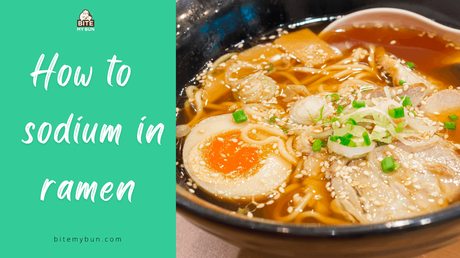Ramen has over 30 percent of your daily sodium per serving, so you might want to know how to lower that.

The best ways are to rinse your noodles, use less of the seasoning, add something healthy to your ramen, or make your own.
Four ways to reduce sodium in ramen
Rinse the noodles
Whether you cook your noodles on the stove or in the microwave, a good method to lower the sodium in your meal is by rinsing your noodles.
When they’re close to being done, drain the ramen in a strainer.
When you put the noodles back, pour about half to 1 cup of water into the pot or bowl and finish cooking them. Draining the water will take some of the sodium out with it.
Seasoning
The seasoning packet in your ramen is the main source of sodium, but the good news is there are 3 ways to reduce it.
The first is simple: just use less seasoning. If you’re worried about less flavor, try adding natural herbs or spices to make up the difference.
Here I explain how to make instant ramen without the packet.
The seasoning will naturally mix with the water to make broth, so you should do your best to avoid it.
Some people go the extra measure by draining them again after the seasoning is mixed in, but as long as you don’t drink the broth you’ll avoid most of the sodium.
A good alternative to the seasoning and broth is to use a broth of choice from the store, preferably low-sodium. This is especially good if you’re planning to make your own ramen as described later.
Eat it with something healthy
Of course, since a large part of the sodium is in the seasoning you can simply not add the packet. Boiling the noodles in water and eating them as part of a healthier meal is the best option.
Several vegetables have little to no sodium, like green beans and corn which are actually in the pre-made cups of noodles. Other vegetables typically found in noodle dishes are carrots, onions, mushrooms, and cabbage.
Not only will they add flavor to your ramen if you choose not to use the full seasoning, but they’ll fill you up faster and potentially make you eat less.
Just be careful with any canned vegetables because they can have more sodium than fresh ones, especially mushrooms.
Make your own
As with many meals, making your ramen from scratch is the healthiest option. The steps are similar to cooking your ramen as usual, but it will take a little more work.
Pick your noodles. The most common choices are chow mein and lo mein, but it’s all about preference. Cook them like you normally would by boiling water on the stove.
Or if you want to get really adventurous, you can buy a ramen machine and make your own noodles.
The biggest difference is seasoning because you’ll want to make your own. You can use trial and error to find the right balance of herbs and spices or you can try to find sodium-free seasoning packets at the grocery store.
Traditional shio ramen broth is great to start with for beginners.
Another possibility is to use cubed or powdered bouillon but in small doses. The sodium in bouillon is pretty high, too.
Because of your healthier broth, you don’t have to worry about draining or avoiding it so feel free to eat it like that or add vegetables for a full meal.
Herbs and spices for ramen
In case you’re wanting to use your own flavor combinations, some of the best ones to get you started are garlic or onion powder, black pepper, ginger, and low-sodium soy.
For added spice, some people add sriracha or flakes of red pepper.
Besides bouillon, sodium-free seasoning, and store-bought or homemade broth, you can also add a little miso to your water to create a miso ramen broth.
If you’re worried about missing out on the meaty flavor, though, you can always add a protein of choice to your noodles.
Next, read about the 9 best ramen toppings to order or use when making ramen at home
